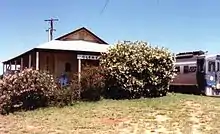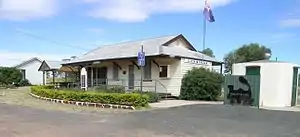Glenmorgan railway line
The Glenmorgan Branch is a railway line in south west Queensland, Australia. It opened in a series of sections between 1908 and 1931. It was intended to reach Surat but construction ceased during the 1930s depression and never recommenced.




History
After the Western Line from Brisbane, Australia opened beyond Dalby in the 1870s and the South Western Line passed beyond Warwick in the early 1900s, there was agitation for a service west from Dalby towards Tara. An 84 kilometre extension between the two towns was approved by parliament in April 1908. There was some delay in construction as completion of the Haden and Cooyar branch lines was given priority.
The first section of the line opened as far as Kumbarilla on 8 September 1911 including stops at:[1][2]
- Dalby (27.1800°S 151.2717°E)[3]
- Natcha (approx 27.1790°S 151.2519°E) serving the Dalby Butter Factory[4][5]
- Yumborra (27.1839°S 151.2336°E) added in 1956 [6]
- Nandi (27.2139°S 151.1714°E)[7]
- Kupunn (27.2267°S 151.1142°E)[8]
- Duleen (27.2403°S 151.0542°E)[1]
- Ducklo (27.2531°S 151.0114°E)[9]
- Gulera (27.2944°S 150.941°E)[2]
- Kumbarilla (27.3150°S 150.8761°E)[10]
On 4 October 1911, the line opened to Tara, including stops at:[2]
- Weranga (27.3044°S 150.7281°E)[11]
- Bungybah (27.2853°S 150.6609°E)[2]
- Goranba (27.2869°S 150.6003°E)[12]
- Perthton (27.2885°S 150.5612°E)[2]
- Tara (27.2775°S 150.4567°E)[13]
A mixed train left Dalby three days a week at noon for the 4¼ hour journey to Tara leaving again the next morning at 11.30am for the return trip.
Slow progress west
An 80-kilometre extension to Surat was approved by parliament in December 1914 to service dairy and sheep farms en route.[14] The line never reached Surat but four short stages opened progressively as far as Glenmorgan over the ensuing 17 years. Construction began but was suspended between 1916 and 1923. On 24 August 1925, the line was extended to The Gums with stops at:[2]
- Tullagrie (27.2803°S 150.3858°E)[15]
- South Glen (27.3053°S 150.3167°E)[16]
- Cabawin (27.3294°S 150.2503°E)[17]
- The Gums (27.3286°S 150.1853°E)[18]
Two of the three weekly trains travelled the extra distance. Two short stages were opened to:[19]
- Hannaford (27.3264°S 150.0650°E) on 28 June 1926 [20]
- Meandarra (27.3219°S 149.8861°E) on 2 July 1927 [21]
From 1928, a rail motor service ran twice a week to Tara and later to Meandarra.
Another short extension took the line a further 22 kilometres with stops at:[19]
- an unnamed stop (27.2772°S 149.7564°E)[19]
- Glenmorgan (27.2494°S 149.6769°E) opened on 12 December 1931.[22]
The terminus was renamed Glenmorgan in honour of Godfrey Morgan the Railways Minister between 1929 and 1932. Streets in the town were named after his family and he was also honoured with the naming of Morganville a railway terminus south-west of Bundaberg.
A twice-weekly goods train and a similar rail motor service operated between Dalby and Glenmorgan. Grain gradually accounted for much of the traffic and special grain services became commonplace. Road transport took over transport of general goods to the point where only seasonal grain traffic remains and then only as far as Meandarra.
The line beyond Meandarra was closed on 26 June 2013.[23]
Contemporary line standards
The maximum grade is 1 in 44 (~2.3%) and the minimum curve is 400m radius. The line currently is laid with 41 & 30 kg/m rail, 25% steel sleepers and a 15.75 tonne axle load, except for west of Meandarra, which was 21 kg/m with a 10 tonne axle load.
The line speed is 60 km/h to Tara, 40 km/h to Meandarra and was 30 km/h to Glenmorgan.
References
- "Dalby" (Map). Queensland Government. 1950. Retrieved 25 April 2020.
- "Queensland Two Mile series sheet 2m47" (Map). Queensland Government. 1939. Archived from the original on 24 April 2020. Retrieved 25 April 2020.
- "Dalby – railway station in Western Downs (entry 39179)". Queensland Place Names. Queensland Government. Retrieved 25 April 2020.
- "Model Structure". The Brisbane Courier. Queensland, Australia. 22 November 1927. p. 16. Retrieved 25 April 2020 – via Trove.
- "About Us". Dalby Rural Supplies. Retrieved 25 April 2020.
- "Yumborra – railway station in Western Downs Region (entry 38801)". Queensland Place Names. Queensland Government. Retrieved 25 April 2020.
- "Nandi – railway station in Western Downs Region (entry 23791)". Queensland Place Names. Queensland Government. Retrieved 25 April 2020.
- "Kupunn – railway station in the Western Downs Region (entry 18629)". Queensland Place Names. Queensland Government. Retrieved 25 April 2020.
- "Ducklo – railway station in the Western Downs (entry 10718)". Queensland Place Names. Queensland Government. Retrieved 25 April 2020.
- "Kumbarilla – railway station in Western Downs Region (entry 18595)". Queensland Place Names. Queensland Government. Retrieved 25 April 2020.
- "Weranga – railway station in Western Downs Region (entry 37005)". Queensland Place Names. Queensland Government. Retrieved 25 April 2020.
- "Goranba – railway station in Western Downs Region (entry 14369)". Queensland Place Names. Queensland Government. Retrieved 25 April 2020.
- "Tara – railway station in Western Downs Region (entry 33318)". Queensland Place Names. Queensland Government. Retrieved 25 April 2020.
- Kerr, John (1990). Triumph of narrow gauge : a history of Queensland Railways. Boolarong Publications. pp. 115, 151, 225. ISBN 978-0-86439-102-5.
- "Tullagrie – railway station in Western Downs Region (entry 35285)". Queensland Place Names. Queensland Government. Retrieved 25 April 2020.
- "South Glen – railway station in Western Downs Region (entry 31458)". Queensland Place Names. Queensland Government. Retrieved 25 April 2020.
- "Cabawin – railway station in Western Downs Region (entry 5606)". Queensland Place Names. Queensland Government. Retrieved 25 April 2020.
- "The Gums – railway station in Western Downs Region (entry 33962)". Queensland Place Names. Queensland Government. Retrieved 25 April 2020.
- "Queensland Two Mile series sheet 2m48" (Map). Queensland Government. 1955. Archived from the original on 24 April 2020. Retrieved 25 April 2020.
- "Hannaford – railway station in Western Downs Region (entry 15331)". Queensland Place Names. Queensland Government. Retrieved 6 June 2019.
- "Meandarra – railway station in Western Downs Region (entry 39287)". Queensland Place Names. Queensland Government. Retrieved 25 April 2020.
- "Glenmorgan – railway station in Western Downs Region (entry 14009)". Queensland Place Names. Queensland Government. Retrieved 25 April 2020.
- "Southern Queensland line diagrams" (PDF). Queensland Rail. November 2013. Retrieved 24 April 2014.